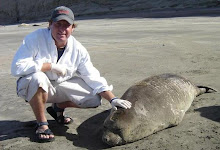Whether it is farm raised or wild caught, shrimp is simply a bad choice if you care at all about the ocean or, more broadly, the future of our own survival as a species. And no, it is not because we are going to eat all the shrimp and cause their extinction...! This is not a single species issue. This is an issue of bad practices and total ecosystem destruction. The fishery, familiar to much of the U.S. public largely due to the romanticization of the Gulf Coast industry (e.g. in the film Forrest Gump), is a trawl-based fishery. Not as well known are that these trawls capture 10 lbs of bycatch (unwanted ocean wildlife) for every 1 lb of shrimp! This bycatch includes fish, other crustaceans, sharks, dolphins and most notably, sea turtles!
 In fact, the trawl fishery is a major contributor to the decline of sea turtle populations in many parts of the world. Furthermore, these trawls scrape the bottom clean, removing the entire benthic ecosystem. Dr. Sylvia Earle compares this practice to "clearcutting forests to capture songbirds". All breeding, nesting, grazing and refuge habitat (including that needed by the shrimp themselves) is left in shattered remains from these trawls.
In fact, the trawl fishery is a major contributor to the decline of sea turtle populations in many parts of the world. Furthermore, these trawls scrape the bottom clean, removing the entire benthic ecosystem. Dr. Sylvia Earle compares this practice to "clearcutting forests to capture songbirds". All breeding, nesting, grazing and refuge habitat (including that needed by the shrimp themselves) is left in shattered remains from these trawls.These days, many people look to aquaculture as a solution to our problems with overfishing. But not so fast! While there are great examples of industrial aquaculture (catfish and tilapia come to mind...), the shrimp farming industry as a whole is just not there yet. This industry saw explosive growth in the 1980s-90s within tropical developing nations such as Thailand, Ecuador and Honduras. But what was experienced on the ground was not a boost of income and livelihood for these nations, but quite the opposite. Hundreds of square miles of mangrove wetland (invaluable in its own right as nursery ground for fisheries and a protective barrier for coastal regions) were clearcut to make room for shrimp ponds. The initial clearing of mangroves forced many local and indigenous people off of their homelands as well as removed their primary source of sustenance (sustainable harvesting of seafood/mangrove natural resources). But what happened next was arguably even worse. The intensive monoculture led to widespread pollution of estuaries resulting in the decline of coastal fisheries, the die off of native crustracean species and finally, in many areas, to the collapse of the farming industry itself due to the spread of disease.
Since those days, the aquaculture industry has made leaps and bounds in developing the technology for a more sustainable approach to farm raising shrimp. However, shrimp raised under these improved practices are oftentimes not easily available on the market. So, better to hold off on your coconut shrimp feast until the industry can catch up with the technology!
But, if you absolutely must eat shrimp, check out http://www.shrimpsuck.org/ for great leads on where to source some of this sustainable shrimp. If in Florida, Publix offers "Florida sweet shrimp" sourced from Ocean Boy Farms. This is a great place to start.


check out the ShrimpSuck.org Viral Video Contest! at www.shrimpsuck.org
ReplyDelete